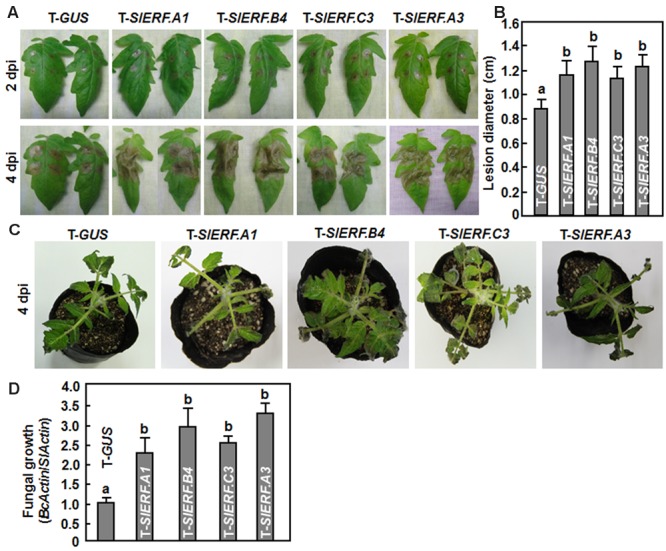FIGURE 4.

Silencing of SlERF.A1, SlERF.A3, SlERF.B4, and SlERF.C3 resulted in increased susceptibility to B. cinerea. Two-week-old seedlings were infiltrated with agrobacteria carrying pTRV2-SlERF.A1, pTRV2-SlERF.A3, pTRV2-SlERF.B4, pTRV2-SlERF.C3, or pTRV2-GUS and disease assays were performed on detached leaves and whole plants at 4 weeks after VIGS infiltration. Inoculation with B. cinerea was done by dropping 5 μl of spore suspension (2 × 105 spores/ml) on surface of the detached leaves or foliar spraying onto leaves of whole plants. (A) Disease symptom and progress on detached leaves of pTRV2-SlERF.A1-, pTRV2-SlERF.A3, pTRV2-SlERF.B4-, pTRV2-SlERF.C3-, or pTRV2-GUS-infiltrated plants at 2 and 4 days post inoculation (dpi). (B) Lesion sizes in leaves of the pTRV2-SlERF.A1-, pTRV2-SlERF.A3, pTRV2-SlERF.B4-, pTRV2-SlERF.C3-, or pTRV2-GUS-infiltrated plants at 4 days post inoculation. At least 10 leaves from ten individual plants were used for each experiment. (C) Disease phenotype on representative inoculated plants at 4 days post inoculation. (D) Growth of B. cinerea in inoculated leaves of pTRV2-SlERF.A1-, pTRV2-SlERF.A3, pTRV2-SlERF.B4-, pTRV2-SlERF.C3-, or pTRV2-GUS-infiltrated plants. Fungal growth in planta was assumed at 4 days after inoculation by qRT-PCR analyzing the transcript levels of B. cinerea BcActinA gene using SlActin gene. Relative fungal growth was shown as folds of transcript levels of BcActin compared to SlActin. Data presented in (B) and (C) are the means ± SD from three independent experiments and different letters above the columns indicate significant differences at p < 0.05 level.
